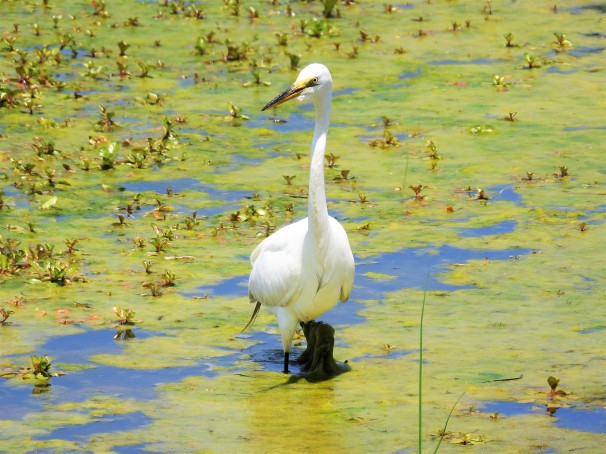The Great Egret (Ardea alba), also known as the Common Egret, Large Egret or (in the Old World) Great White Heron, is a large, widely-distributed egret, with four subspecies found in Asia, Africa, the Americas, and southern Europe. Distributed across most of the tropical and warmer temperate regions of the world. It builds tree nests in colonies close to water.

Great Egret
The Great Egret is a large heron with all-white plumage. Standing up to 1 m (3.3 ft) tall, this species can measure 80 to 104 cm (31 to 41 in) in length and have a wingspan of 131 to 170 cm (52 to 67 in). It is thus only slightly smaller than the Great Blue or Grey Heron (A. cinerea). Apart from size, the Great Egret can be distinguished from other white egrets by its yellow bill and black legs and feet, though the bill may become darker and the lower legs lighter in the breeding season. In breeding plumage, delicate ornamental feathers are borne on the back. Males and females are identical in appearance; juveniles look like non-breeding adults. Differentiated from the Intermediate Egret (Mesophoyx intermedius) by the gape, which extends well beyond the back of the eye in case of the Great Egret, but ends just behind the eye in the case of the Intermediate Egret.

Great Egret
It has a slow flight, with its neck retracted. This is characteristic of herons and bitterns and distinguishes them from storks, cranes, ibises, and spoonbills, which extend their necks in flight. The great egret walks with its neck extended and wings held close. The Great Egret is not normally a vocal bird; it gives a low, hoarse croak when disturbed, and at breeding colonies, it often gives a loud croaking cuk cuk cuk and higher-pitched squawks. [Wikipedia]

Great Egret
The elegant Great Egret is a dazzling sight in many a North American wetland. Slightly smaller and more svelte than a Great Blue Heron, these are still large birds with impressive wingspans. They hunt in classic heron fashion, standing immobile or wading through wetlands to capture fish with a deadly jab of their yellow bill. Great Egrets were hunted nearly to extinction for their plumes in the late nineteenth century, sparking conservation movements and some of the first laws to protect birds. [All About Birds]
Great Egret Facts [All About Birds]
- The Great Egret is the symbol of the National Audubon Society, one of the oldest environmental organizations in North America. Audubon was founded to protect birds from being killed for their feathers.
- The pristinely white Great Egret gets even more dressed up for the breeding season. A patch of skin on its face turns neon green, and long plumes grow from its back. Called aigrettes, those plumes were the bane of egrets in the late nineteenth century, when such adornments were prized for ladies’ hats.
- Not all young that hatch survives the nestling period. Aggression among nestlings is common, and large chicks frequently kill their smaller siblings. This behavior, known as siblicide, is not uncommon among birds such as hawks, owls, and herons, and is often a result of poor breeding conditions in a given year.
- The oldest known Great Egret was 22 years, 10 months old and was banded in Ohio.








They don’t get much exposure but Egrets are beautiful!!
LikeLike
Yes they are!
LikeLiked by 1 person
This sumptuous bird made is worth watching on a daily basis…As always you nailed it!
Great shot friend!😉🌏🎶
#Stunning
#Magiclense🗺🌏🗺
LikeLike
Thank you.
LikeLiked by 1 person
Mmmm! Sure Ren! THANK YOU!😆🌎
LikeLiked by 1 person
Beautiful photos! Enjoyed reading the facts. 🙂
LikeLike
Thank you. ☺
LikeLike
They are gorgeous birds, so elegant. We have them mostly in our wetland areas and near fish ponds…
LikeLike
In Jamaica? I didn’t know that.
LikeLike
I have noticed you don’t monetize your page, don’t waste your traffic, you can earn additional bucks every month because you’ve
got high quality content. If you want to know how to make extra bucks, search for:
Boorfe’s tips best adsense alternative
LikeLike